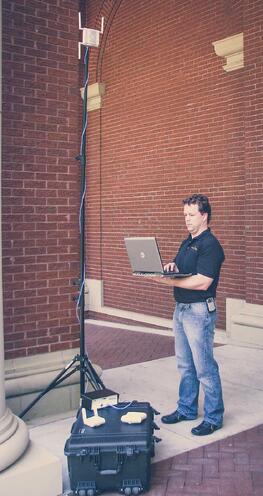
At SecurEdge, my office is next to Michael McNamee who is head of our professional services group. Our office is a converted warehouse/techy kind of office place with stained concrete floors, so when Michael is on the phone, I hear much of the conversation. I’m struck by how many phone calls he gets from prospective customers calling with wireless performance issues that are simply a matter of improper planning from their current WiFi provider. Many times, the wireless company just threw up some access points down the hallway with no real thought into how the technology works and how access point placement directly affects WiFi performance.
 To save yourself some pain, we recommend having a WiFi site survey completed if you’re planning for 802.11ac WiFi. This doesn’t necessarily mean you need a physical site survey; you may just need a predictive RF design completed using software.
To save yourself some pain, we recommend having a WiFi site survey completed if you’re planning for 802.11ac WiFi. This doesn’t necessarily mean you need a physical site survey; you may just need a predictive RF design completed using software.
(Here’s an article explaining the difference). But you definitely need some sort of wireless plan if you want to get the fastest speeds, here’s why:
1) 802.11ac range is dictated heavily by AP location.
Wireless ac can bounce signal off walls to give it more range. This can be great to help increase the distance of the signal, but this also creates problems if the access points are too close to each other.
The “down the hall” deployment approach of 2008 used to be a great way to deploy wireless. It’s not today. Putting multiple access points in the same hall will mean the reflective signals will interfere with each other more than in previous wireless versions.
The interference either means the system won’t perform as well (best case) or worst case, it adjusts power down so that it can’t see itself as easily which means you don’t have the coverage you need for users to connect (worst case).
2) 802.11ac Access Points need to be sized for the right capacity for coverage areas.
Wireless capacity has been one of the biggest problems with the explosion of mobile devices.
The answer from the WiFi manufacturers is to design many different types of access points for many different types of usage. But this requires some capacity and usage planning.
In other words, you match the capacity of the area and the functionality of the wireless devices to the access points in that area. This can be tricky, if you over-engineer, you spend way more money than you need to and your system will interfere with itself.
If you under engineer, you won’t have the capacity you need where you need it. This is why it’s best to have a wireless expert working with you as you go through the Wi-Fi engineering process, starting with a predictive WiFi site survey.
Suggested Article: How to Optimize Your Wireless Network Design for Mobile Devices
3) Picking the right wireless solution is the biggest indicator of Wi-Fi performance.
I’ve seen great wireless solutions installed improperly and the user has had wireless issues. But I’ve never seen a crappy wireless product installed well work properly. In the end, the customer still has a bad solution.
The different manufacturers have strengths and weaknesses for each type of area and each market. It’s important to make sure that you’re selecting the right manufacturer as far as features go, as well as the right antennas and ancillary parts that go along with making sure you’ve got the right system deployed for your company.
The results of a properly completed site survey should include making a recommendation on what WiFi will best work for your business, and the engineer should be able to explain why.
At SecurEdge, we deliver affordable, robust, and secure wireless platforms – it’s all we do. If you have any questions about wireless network design or would like to discuss an upcoming project, please contact us here.




